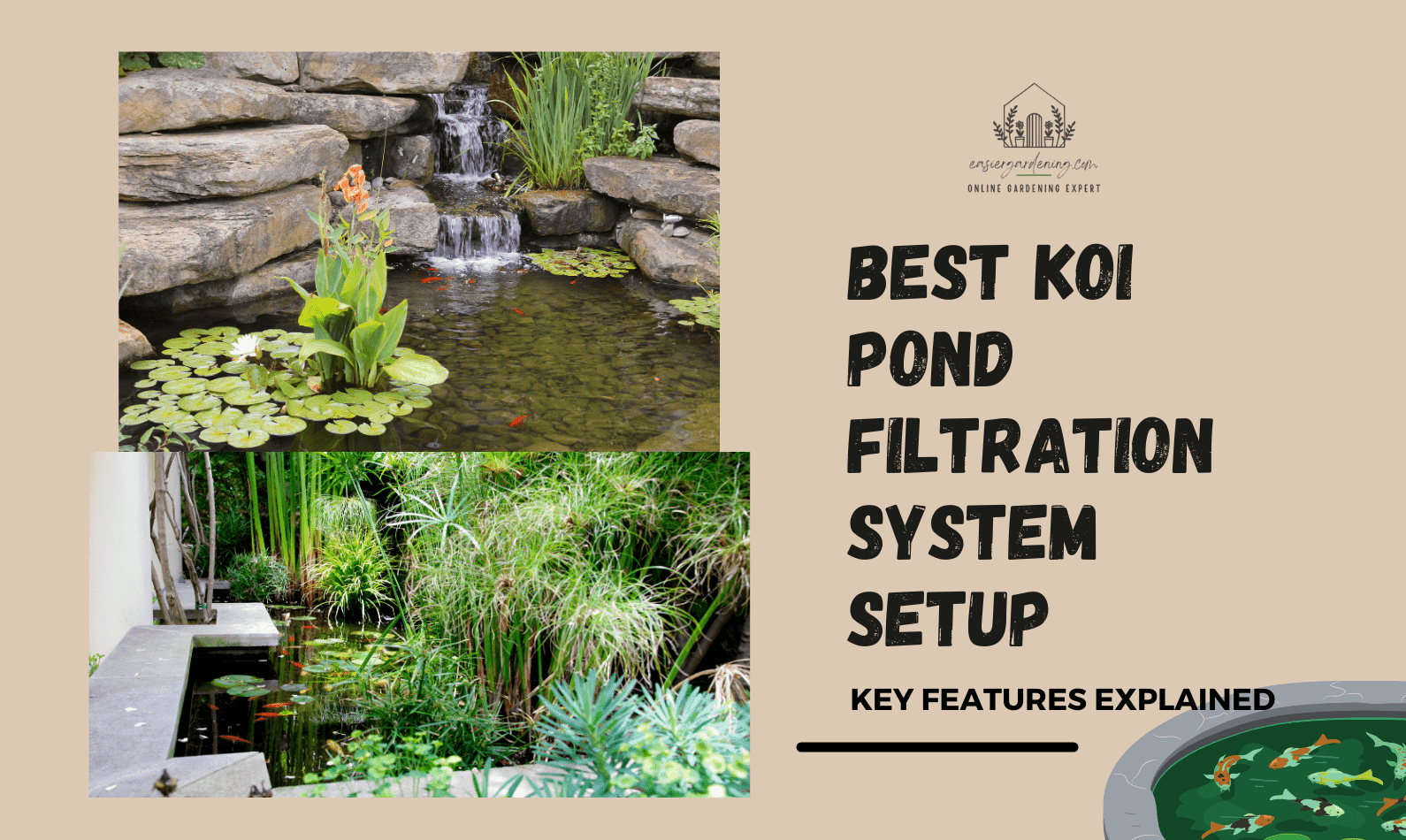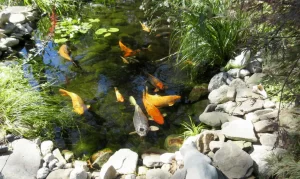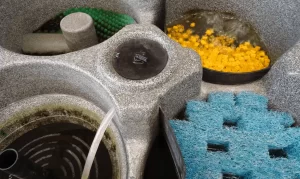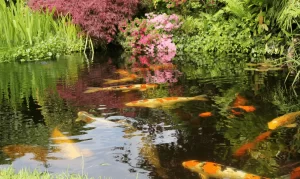The Best Koi Pond Filtration System Setup: Planning, Installation, & Care: A koi pond in your garden will definitely make it extraordinary. But installing the system can be a matter of headache. However, if you are interested in building it, it is best to plan everything beforehand. When designing it, first of all, you must consider the needs of your koi.
When building a koi pond, because of the many small details, you need to think about everything thoroughly and make the right decisions based on that. The colorful koi will not feel comfortable in a conventional goldfish pond. A perfect koi pond differs from a regular garden or goldfish pond in several ways. So, it is important for you to find out the best koi pond filtration system setup & provide the best care for it.
Contents
Right Location, Size, & Depth for the Pond: Best Koi Pond Filtration System Setup
You need to set up your koi pond in a way that it gets open to two-thirds in the sun during the day & one-third in the shade. This way, on sweltering summer days, the water in your koi pond will not heat up too much.
Adult koi carp reach a size of 1.50 meters and grow for life. Pond size does not affect how large your koi will grow. However, koi generally grow faster in a large pond. An adult koi needs at least 1,000 gallons of water to be comfortable. For you, this means that the more of these beautiful ornamental fish you want to keep, the larger your koi pond will need to be. However, a koi pond should be not only large but also deep.
It must be deep enough to prevent freezing to the bottom of the pond in winter. For a group of 10 to 20 koi, the pond should be at least 10 to 20 square meters and preferably have a depth between 180 and 200 centimeters.
Koi Pond Filter System DYI: It is better to do without deciduous trees to provide shade on the pond bank. Otherwise, the leaves falling from the trees into the pond in autumn will cause you a lot of extra work. Suitable shade trees are conifers, some bamboo species (with rhizome barrier), and Chinese grass.
Dimensions & Other Characteristics
Koi are very social fish. Keeping them individually would be cruel to them. Koi must be kept in groups of at least ten fish if you want to be sure that they are comfortable. Koi grow not only very large but also very old. Some of the magnificent color carp have been known to live over a hundred years.
Expert Tips: Steep walls protect your precious koi from herons, which may try to prey on the handsome koi. The walls should be designed as steep as possible.
Proper Planning of Surroundings
For the best koi pond filtration system set up, planning the immediate surroundings is essential. You should design your koi pond to blend harmoniously with your garden. If you plan to equip the pond with seating, you should build it next to your covered patio. On rainy days, you can enjoy your colorful koi at any time. You can install sockets on the terrace to connect the pond filter, pond pump, and pond lighting.
Furthermore, the sockets, cables, and technical equipment must comply with the VDE standards for outdoor installations across the board. If you create your koi pond in a rectangular shape, riparian planting softens the unnatural, somewhat severe-looking pond shape. Planting also offers the advantage that the plants enrich the pond water with additional oxygen.
Expert Tips: It is essential to keep a minimum distance of 3 meters between the pond and the electrical equipment to avoid an unwanted electrical blow-up.
Technical Equipment
Koi pond filter setup is essential because it works as a skimmer that keeps the water surface free of leaves, grasses, and other organic materials falling into the pond. Furthermore, you need to install a filter with a biological and a mechanical filtration stage. The pond filter and the stream must be connected to a powerful pond pump.
When choosing a pond filter, you should opt for a model with several filter chambers that can be opened and cleaned independently. For the best koi pond construction, you need to find the best combination of koi pond pump and filter. A diaphragm pump to which an aerator is connected is a sensible investment. It ensures that the water is circulated regularly and kept moving and that additional oxygen is added to the water.
Expert Tips: You should also install a UVC unit. UV light kills bacteria and germs that koi are particularly sensitive to and prevents any fish diseases from spreading in your pond. The formation of algae growth is effectively inhibited by UV light.
Suitable Materials to Use in Building the Pond
A variety of materials are suitable for building the best koi pond filtration system setup. Exceptionally durable is a concrete pond, further coated with a layer of polyester reinforced by glass fibers.
Learn about How to Kill a Tree Without Anyone Knowing?
This type of pond offers you the possibility of integrating thermal insulation between the concrete wall and the polyester layer on top of it. If you need to temporarily dry out the pond at some point in the future, you can quickly remove the algae growing on the concrete walls with a standard high-pressure cleaner.
Plants to Use in Koi Pond
Koi ponds are usually not planted or only sparsely planted. The reason for this is that the koi will nibble, pull out and eat the plants. However, if you do not want to do without planting & are searching plants for around the koi pond, you may have a solid reason for that. In most cases, the reason is that the plants perform a vital filtering function in the koi pond; you can divide it into two areas.
For example, the planted part is separated from the area where your koi live. The aquatic plants nevertheless ensure a stable biological balance in both areas. An alternative is planted islands that float on the pond. The planted islands give your koi pond a natural look, and most importantly, koi cannot damage the plants.
Now you have to find out what plants will koi not eat. Some species are neither nibbled nor eaten by the koi. This includes, for example, the “yellow water lily.” Cattails are also very hardy plants that are scorned by the koi. If you feed the fish a varied and adequate diet, your koi may have no interest in the pond’s aquatic plants.
Final Thought: Best Koi Pond Filtration System Setup
The larger you have built your koi pond, the more maintenance is required. The best koi pond filtration system setup needs the best care also. The pump, filter chambers, and skimmer screen should be cleaned at regular intervals. If you have built your koi pond with liner, you will need to check every six months to see if the pond’s edge is still intact or if water is leaking out in one or more places.
Expert Tips: The mud that forms on the bottom of the pond over time should be conveniently vacuumed from time to time with a mud lifter.




